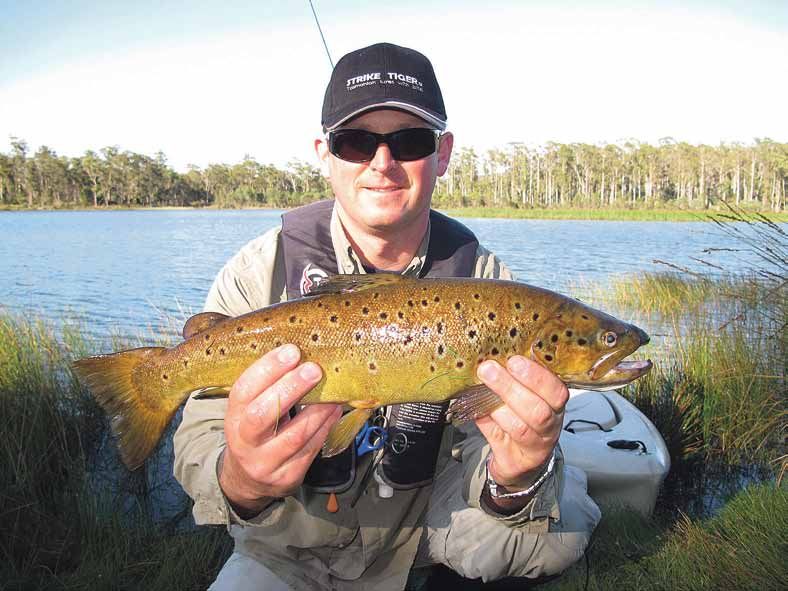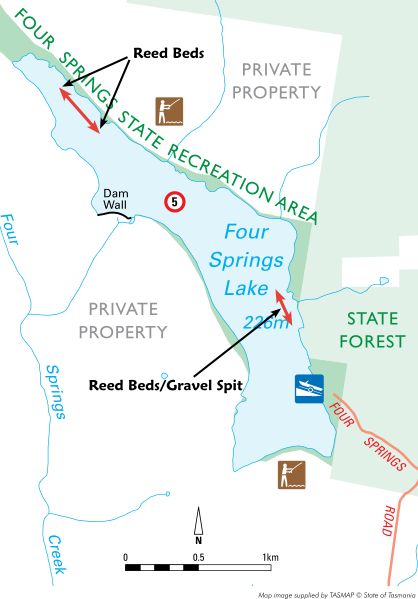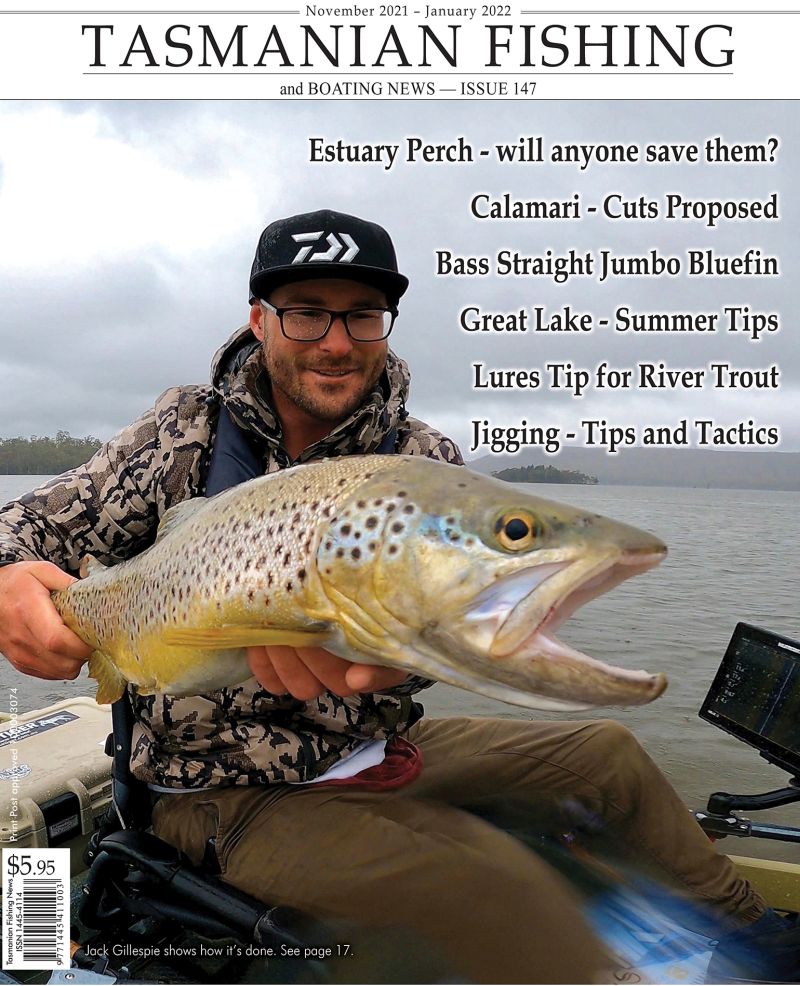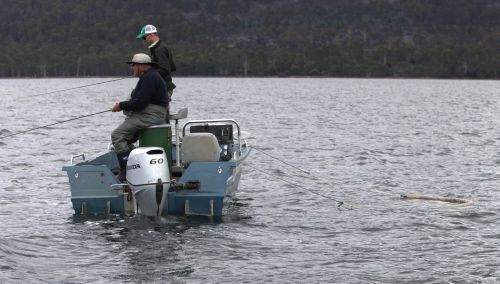 Presented from Issue 96
Presented from Issue 96
For the avid fly fisherman, Four Springs Lake is a pretty good option in the warm weather. Close to Launceston and super convenient for that after work trip. But ask any lure fisherman what Four Springs fishes like in the summer and you will probably get a reply consisting of something like “…the weed is really bad – it’s not worth the trip.” I think the first part of this answer is totally correct. It is a well-known fact that underwater weed growth increases with warmer water temperatures. Casting lures becomes difficult and trolling is near impossible. Weed every cast – definitely not anyone’s cup of tea.
To top it off, your target, the humble trout, has a changed taste. No longer is he fixated on chasing galaxias or his smaller cousins. The warm weather means that there is a smorgasbord of insects on offer. As a result, trout are usually picky at this time of the year. Lures, both hard-body and soft-plastic, are no longer the favourite things on the menu. As if the weed isn’t frustrating enough!
However, I disagree with the second part of the answer. Four Springs can still be a good place to fish during the warmer weather - especially from a kayak. You just have to re-think your approach and consider what is on the menu and where it can be found. This is where different tactics come into play. Let’s not also forget the value of patience and determination – important for the methods that I am about to describe.
Timing is critical
Trout are a cold water species and as such, don’t take well to swimming around in water that can be compared to a warm bath at your grandmother’s house. Again, common sense suggests that on a hot summer’s day, the water will begin to cool as night sets in. Water will obviously be at its coolest temperature early in the morning, having had the night to cool down substantially. Most of us already know that early morning is a good time to target trout – if not the ultimate time. So this is the first part to successful summer fishing at Four Springs - get up very early and be on the water as the sun rises.
The weather conditions are also worth a mention. An ideal day would be not too sunny, and with a bit of cloud cover. Throw in some choppy water conditions and your chances of catching something should increase. Rougher conditions will stir up food that is in the water. Trout will generally have increased confidence at these times and will not be as cautious, like they are on bright, sunny days and when the water is calm.
Areas to target (see map)

The reed beds at Four Springs would have to be my favourite places to target at this time of the year. Reeds offer plenty of food for fish in the warmer weather. Mudeyes (dragon fly larvae) and other insects can often be found clinging to such aquatic vegetation. When they drop into the water, they provide an easy meal. I often find trout patrolling hard up against the reeds looking for such opportunities. Depending on water levels in the lake, the depth where the reeds grow is usually around the 1.2 metre mark.
I have experienced some great fishing in these reed beds, particularly in the Northern part of the lake. I have also caught some nice rainbows from the reed clumps that grow just North of the boat ramp. The reeds there grow on an underwater spit that is largely composed of gravel. I have often seen fishermen wading out there when the water levels have been right.
Besides targeting reeds, shaded areas of shoreline are well worth a look. Search for water that is not exposed to direct sunlight. Shady areas will often hold a trout or two in the warmer months. There are several overhanging trees on the Western shore near the dam wall, which provide such shady conditions, particularly in the early morning hours.
Tactics and lure selection
Pedal or paddle your yak directly to the reeds that I have marked on the map. My favourite ones to fish are located at the Northern end of the lake. When I kayak fish for trout, I usually troll hard-body lures in between destinations, so as to make the most of my time on the water. As mentioned previously, this can be difficult or practically impossible when the weeds are particularly thick. Once you have reached your chosen destination, sneak in there very quietly so as to be undetected. I like to pedal the Hobie very hard a good distance from my target. I then stop pedalling. The kayak continues to glide silently into position under its own momentum.
As the kayak begins to slow, I use the rudder to steer it into a position parallel to the edge line of the reeds. Fitting a large sailing rudder to a kayak provides more responsive steering, which can be beneficial at this stage. Make sure you have come to a stop and are within a comfortable casting distance. Next, try a precise cast. Aim to get your lure as hard up against the reeds as you can, without snagging. Precise casting like this is sometimes difficult to get the hang of. But, like anything, it is a skill that will develop with practice.
On my most recent trip, I performed this exact tactic using a “black and gold” Jackall COLT minnow hardbody (65 mm suspending model). I had this lure on my spare rod with around 2 metres of 6lb fluorocarbon leader attached to the main braid line. Being an expensive lure, I was cautious with my first cast not to put it into the reeds. I picked a likely spot, aimed, and fired. The lure landed just short of the reed line which I picked as the target. The water immediately boiled and I felt my heart pound. Direct hit…I was on!
The GoPro camera did a great job in capturing that magic moment. After a good fight, a solid brownie finally surfaced. He didn’t like meeting my net in the water, but eventually came aboard my kayak.
This is a good example of a reaction-style take. This particular trout was obviously lying right near the reeds - more than likely looking for food. Trout I have pulled from the reeds in the past have often contained stomachs full of water boatmen and other such aquatic insects. The lure hitting the water at the right place caught his interest and he instantly and aggressively reacted by striking at the lure.
While on the subject of natural food sources, I must also mention mudeyes. They are top trout tucker at Four Springs, or anywhere else for that matter. The only problem that you will sometimes have is actually finding them. If you can’t find mudeyes in the long grass or reeds that line the banks, then expect to pay top dollar in tackle stores for them. Even then, they can be hard to find in tackle stores during times of high demand. The next best thing is to use an artificial soft- plastic lure to imitate this food source. Strike Tiger, which is a local Tasmanian soft plastic supplier, make a 1” soft plastic nymph in a variety of colours. This lure can be modified to look like a mudeye by simply pulling its legs off with your fingers. You can also use your braid scissors to do the job more accurately. I will then rig one of these on a tiny jighead with plenty of lightweight fluorocarbon leader.
The target is identical to the one I have described above using the hard-body lure – aim for the edge of the reeds. However, the retrieve is totally different to what you would normally use when fishing a hard- body. When a mudeye falls into the water, it sinks. So, naturally, I will just let the soft plastic sink to the bottom after it hits the surface. It’s crucial to watch your line at this point in time and take up as much slack as possible without interfering with the sinking process. The time it takes for the plastic to hit the bottom is not usually too long.
If you see your line move, it’s time to set the hook! But if it makes it to the bottom, then I will ever so slowly twitch it to the surface and repeat the sink. Short and very subtle twitches of only around an inch of your rod tip are the best way to retrieve one of these plastics to the surface. The best colours (in this particular brand) that I have found to work at Four Springs are the ‘black n gold’ and the ‘olive pepper’.
When fishing with hard- body lures, you can’t go past the super effective ‘black n gold’ colour combinations. There are many brand names out there to choose from, but I mainly use the better quality Japanese lures. You will pay much more for them, but the build quality and perfect action make up for it. Jackall Bros, Daiwa and Zipbaits are all brand names that have produced results for me at this lake.
The suspending feature some of these lures have is a real bonus. You can ‘hang’ that hard-body right in front of a fish. A very handy feature, particularly if they are a little picky with your offering. The last thing I will mention in relation to hard- body lures - buy the ones that have the red eyes. I seem to have had more success using lures fitted with these rather than ones without. I am not sure of the reason why, but when something works for me, I stick with it
Leeches
The last few early morning trips to Four Springs I have noticed that there is an abundance of leeches. They seem to be particularly fond of swimming in the water near the boat ramp. They aren’t huge specimens and can be difficult to see if you are not looking for them.
When you are pulling your kayak out of the water at the ramp, take a look along the sides and on the bottom. These little blood-thirsty critters love to swim and attach themselves to the sides of kayaks - as I recently discovered. To avoid getting them on your body, keep covered up. If, however, you do manage to pick up one of these passengers, it is safest to let it finish its meal – it will then drop off by itself. Definitely do not just pull it off. Also avoid using salt or a lighter. These techniques will generally result in the leech regurgitating harmful bacteria into the wound. If you are really not keen on letting the leech hang out with you for a while, do some research on the net – there a some good sites that explain how to properly remove them pre end-of-dinner time.
Blue/green algae
Algal blooms often occur in summer as a result of the higher water temperatures at Four Springs. A recent outbreak has been identified in January of this year. The bacteria can be potentially toxic, so it’s a good idea to check the status of the lake before you go. Information can be found on the Inland Fisheries website or TASFISH.COM. Outbreaks of algae are usually well sign posted at the boat ramp by the Meander Valley Council. In any case, it’s not a good idea to eat fish from the lake when such warnings are in place.
Final thoughts
So to sum it up, the first part to success in the warmer months is to get up at the crack of dawn. My wife thinks I’m totally nuts getting up so early. “You struggle to get up for work, but you bounce out of bed to go fishing?” is her favourite quote! Maybe some of you can relate to this? It is, however, the best time to go fishing. I also know that I will only have a few hours of prime fishing time before the heat of the day sets in. Obviously being well organised the night before a trip is a must. Get to the lake early and well prepared. Avoid wasting precious time - target those reed beds first. If you have no luck, then try areas of water covered by some good shade. Don’t be put off by a bit of weed on your hook here and there. You have to expect it from Mother Nature this time of year. And remember, a bit of determination goes a long way. Put in the time, and you will get the results. Now set those alarm clocks and best of luck!
Mic Rybka




